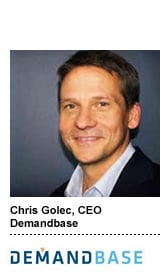 Chris Golec is CEO of Demandbase, which positions itself as a real-time targeting and personalization platform for B2B marketing.
Chris Golec is CEO of Demandbase, which positions itself as a real-time targeting and personalization platform for B2B marketing.
Golec recently spoke to AdExchanger about his company’s new ad platform, known as “Demandbase Company Targeted Advertising.” Read the release.
AdExchanger: How did you get to the advertising “moment” at Demandbase?
CHRIS GOLEC: For most B2B companies, they generally will target between a thousand and 10,000 companies that can buy their products or services. The challenge with digital advertising in B2B is that they can’t just target that specific set of companies. They’re forced to target much larger audiences.
If you do the math, there are 6 million companies in the US but you may only want to target 5,000. That’s a .2% or .3% chance of hitting the right companies with the advertising. As a result, the traffic to customers’ websites has been largely from companies that never will buy anything, and they’ve tried to optimize their websites around audiences that aren’t customers.
The notion of rolling out an advertisement solution with zero waste is what’s disruptive in the marketplace. It mandates the use of IP-based identification versus the use of cookies.
So are you in the same competitive set as a Marketo or a Hubspot?
No. Those are marketing software companies and we plug into those solutions to make them more effective. Our technology platform is all based on real-time identification so that if we plug into a Marketo online forum or a Hubspot online forum, instead of asking a web visitor ten questions, now you only have to ask three because we know the answers to the other seven questions, and you can effectively double or triple your conversion rates.
Can you talk a little bit about your competitive set and then the market size of the opportunity you’re going after?
From a competitive set, the only IP (Internet Protocol) targeting that’s really been done today has been for through geotargeting – such as restaurant ads based on a restaurant’s relative location. There isn’t another solution out there with IP mapped to businesses. So, we have a huge headstart, and we’ve built a very proprietary database that nobody else has where we can actually uncover companies that are hidden behind the Comcast or Verizon [ISP networks], for example.
As far as size of opportunity, we look at companies in the B2B space that have a least 10,000 visits per month or more to their website. Number one, it’s an indication that they’re invested in the Web and the websites are important to them. There’s about 50,000 to 60,000 companies in the US that have that kind of volume of traffic – and, over 60 percent of our database is proprietary information around who is the company behind the IP even though they’re hidden behind the big ISPs.
Customers will spend anywhere from $20,000 to $500,000 per year using our technology to increase their conversion rate, make their website better, and as of today, seeing more of the right customers to their websites.
Can you give us a use case for the new ad platform?
What seems to be resonating is: 1) every B2B company has some special set of accounts, their preferred customer network, or some audience that they want to penetrate. We can quickly tell them that only 4 percent, or whatever it might be, of those companies are active on their site today. By running a campaign with Demandbase, within 30 days we can take that 4 percent over 50 percent because we can serve an ad specifically to those companies you care about.
More engagement on the website leads to sales leads, leads to revenue, and pipeline. It’s a very clear end-to-end tying together of ad impressions served to the right companies, website activity from the right companies, and leads, pipeline, and revenue from the right companies. Demandbase’s platform stitches together ad exchanges, websites, CMS systems, marketing automation and CRM. That’s really the underpinning that pull it all together. And it’s all based on our proprietary IP-to-business data.
What’s your revenue model?
We base it off of a subscription for each module. So if you want to personalize your site, it’s a subscription. If you want to use our conversion module and plug it into your market automation solution, that’s an additional subscription. On the advertising side, we will price using a CPM model. We have some customers that are evolving into a subscription where they want to spend a certain amount per company that they want to target per month.
So, for example, for $200 per month, you can effectively target Hewlett Packard with a very personalized ad. From a sales person’s perspective, that’s incredibly cheap because it would take them forever to call in all month long.
We see customers moving toward this per-account per-month subscription. But, we also sell into it with more traditional, premium, CPM-based pricing.
Our cost for media is much less, obviously, because we know the person behind that IP address is from the HP account, whereas there may not be any kind of business data on that person.
Generally, people are buying based on cookie-based models, and we’re not on that side of it – we’re looking at IP. From a customer value standpoint, there’s value in serving the ad just to the right company. What customers get really excited about is, “Yes, target the ads to the right companies, but now when they come to my website, I can personalize that same message to that company. I can offer a proactive chat. I can measure it with my analytic system, and I can trigger my sales person to call in to that company.” So, now you’re tying advertising together with sales activity.
In regards to your “$200 deal” example for one company, how do you scale this on your end?
Most of our customers are mid-market to large enterprises, and they’re looking at targeting hundreds of thousands of companies. You definitely want to be able to spend enough per month per account to generate engagement from that company. If you don’t spend enough, you’re not going to see the results. From a scaling standpoint, most of the companies we’re selling to today use our technology on their website, so we’re already embedded in that customer. We have our master service agreement in place, we’re an approved vendor, and all those things.
So, we’re introducing to them an extension of our platform that generates a lot more value and fixes a big problem that they have, and that’s bringing the right companies to their websites. From a scaling standpoint, today we’re working closely with customers, and we’re providing some creative services because we’re doing personalization of the ads. I could see 12 months down the road or sooner where you can offer a very easy, full-service model particularly if you wanted to extend this down into smaller companies.
That leads me to the question about funding growth and where you are there. Thoughts?
We’re backed by Sigma Partners, Sutter Hill and Altos Ventures and Adobe is also an investor in the company. Adobe is also a very large customer of ours. I suspect we’ll do one last round of financing. Our revenues have been growing 2-3x per year for the past couple of years. With the technology and the advertising piece, it will give us much greater acceleration. And we will make sure to invest in that growth.
So, you’ve heard about the “marketing stack.” Do you think of yourselves creating a “stack”? Or is there another buzzphraze you might use?
“Stack” sounds a little bit vertical. I think of us as a platform and we’re agnostic. We’ll plug in to whatever stack you have, so to speak. But a customer that uses Marketo, Google Analytics, Salesforce, and they have Drupal for their CMS system — we tie into all those systems. There’s probably not another company that has that exact combination. So everybody’s got a different “stack,” if you will, at least from a customer standpoint. All our modules are done through very simple REST-based APIs [define], so we are independent and agnostic as to which solution you’re using.
Finally, can you talk a bit about how you’re fitting in with the growing world of social and CRM in digital marketing?
We’re doing some things around social CRM in how we push our information into a CRM system. So if you’re following a certain company, we can tie the web activity of that company right into the CRM system so you can inject your chatter feed with HP’s web activity today.
How do we play with LinkedIn and Twitter forthcoming? That’s probably early next year, but there’s a lot of value, which B2B companies want to unlock. They know how many followers they have, but they want to see the industries of those followers. They want to see what portion of their followers are customers or prospects and start layering in real-time analytics in those social feeds.
Finally, what are you doing to address ad creative?
On the advertising side, we’re in a unique position with dynamic creative where you’re actually inserting the company name or industry right into the ad for the visitor. We’re seeing two or three times higher click-through hits through that model. But clients actually care more about, “Are you getting all the companies that are important to me to my site?” And, “What’s the resulting sales activity?” So, there are non-traditional metrics for our business versus a cookie-based model.
One other point here is that we’re the only company that’s leveraging IP to identify a company at-scale through RTB. We’re looking at billions of impressions per day versus a single property which has 1/100th or 1/1000th of the scale.
Follow Chris Golec (@cgolec), Demandbase (@demandbase) and AdExchanger (@adexchanger) on Twitter.














